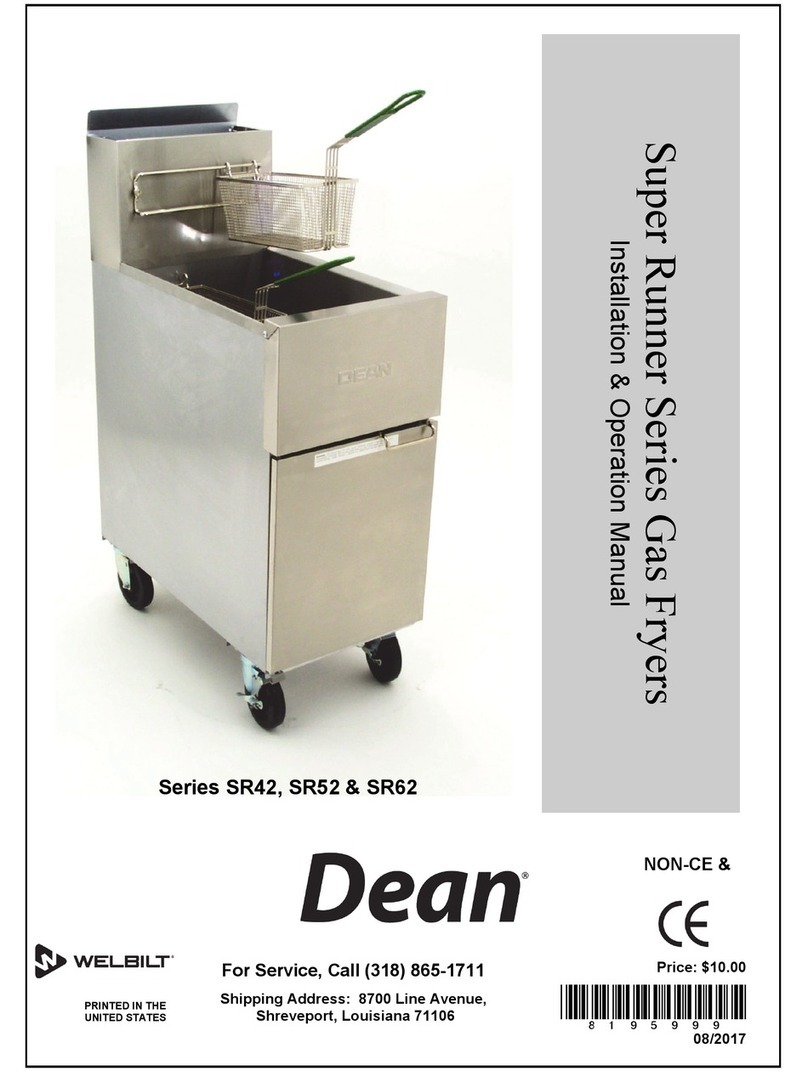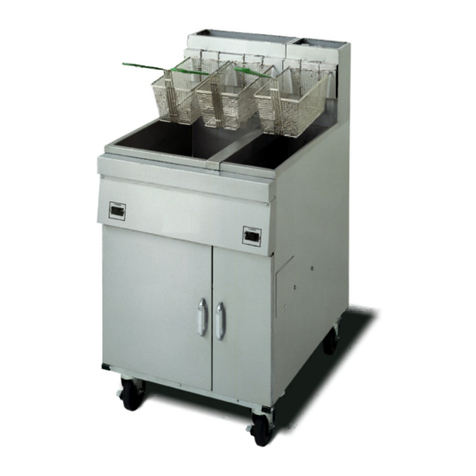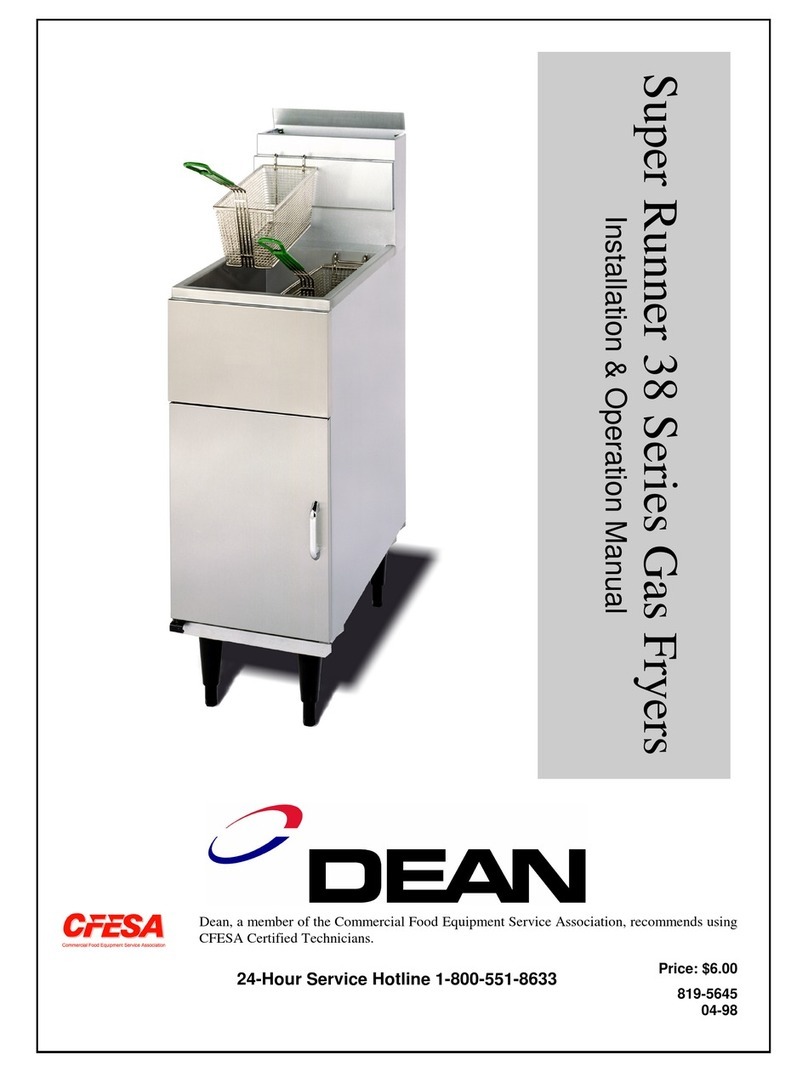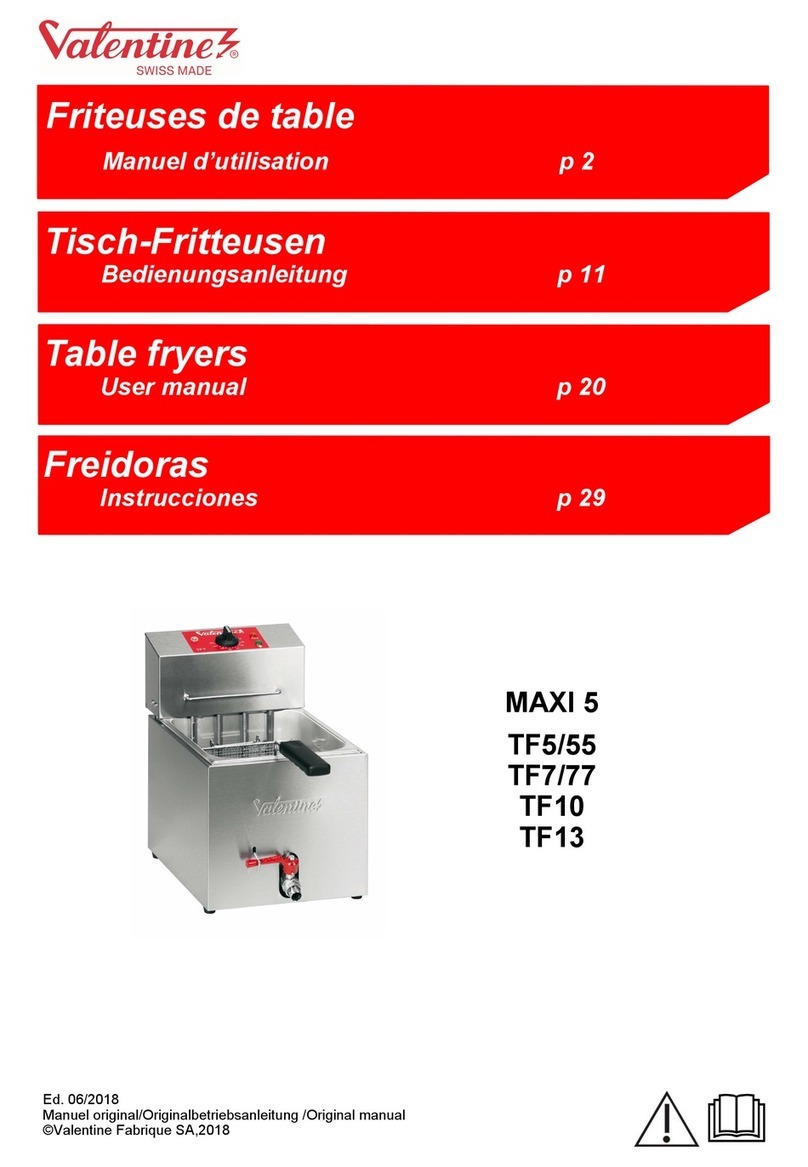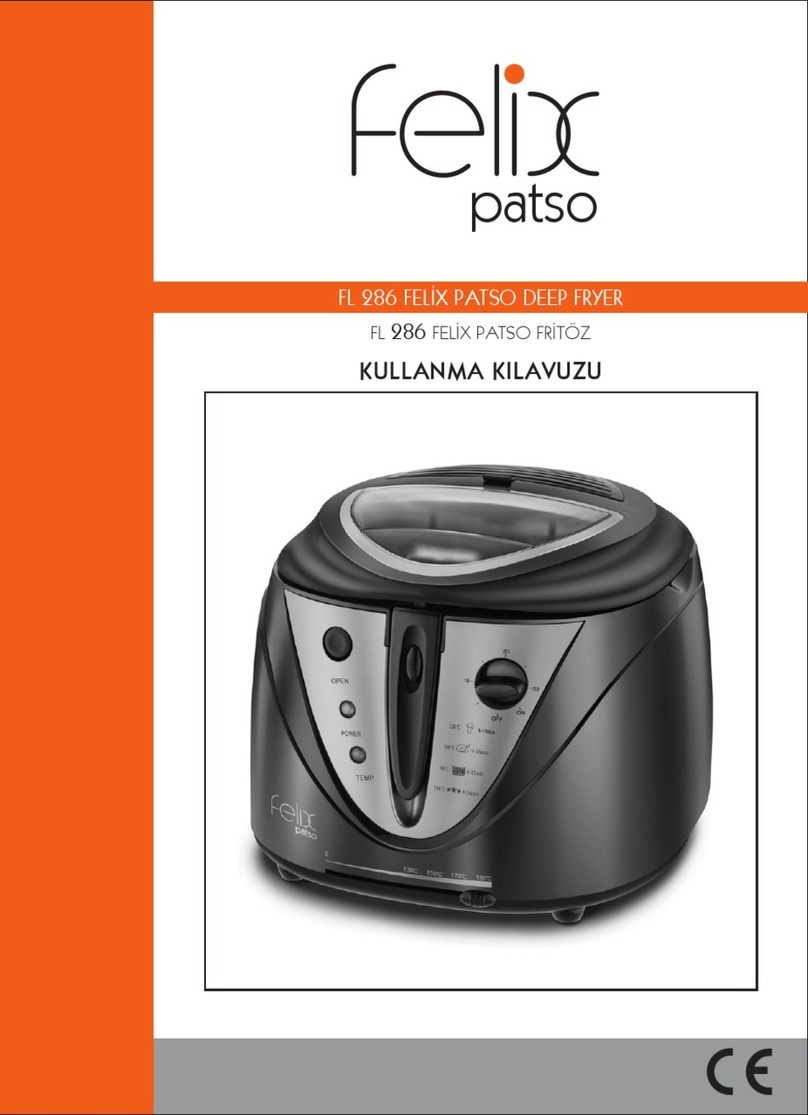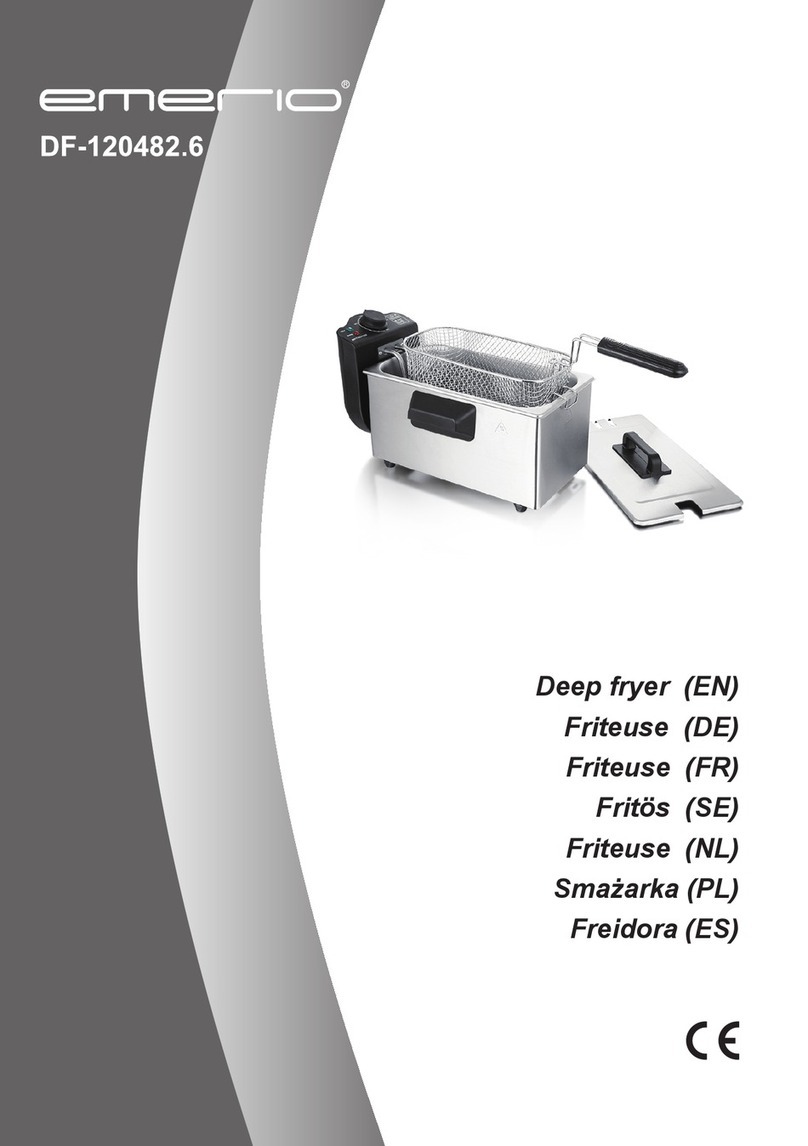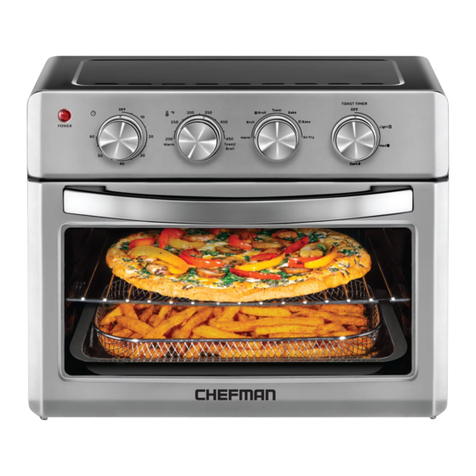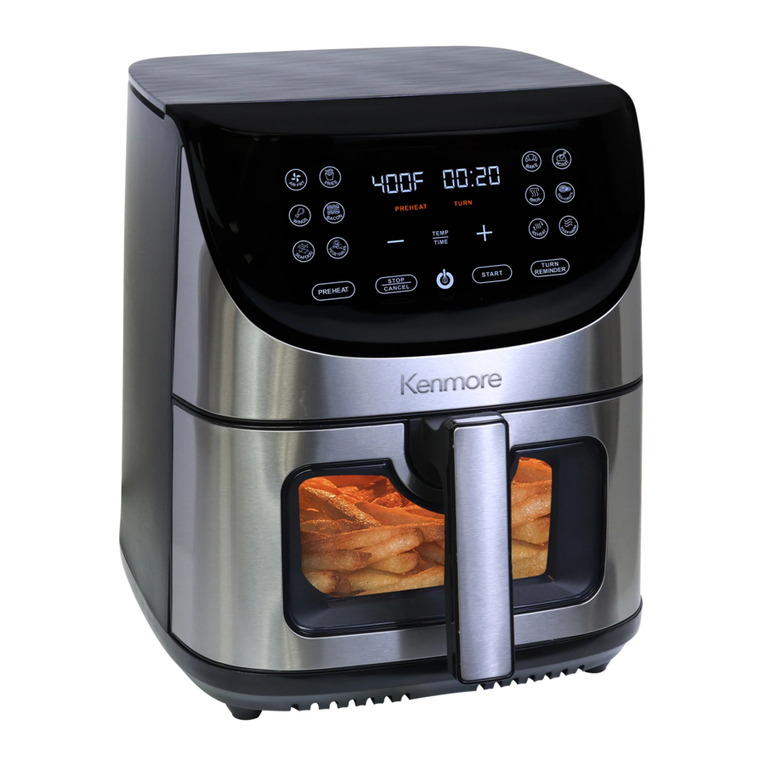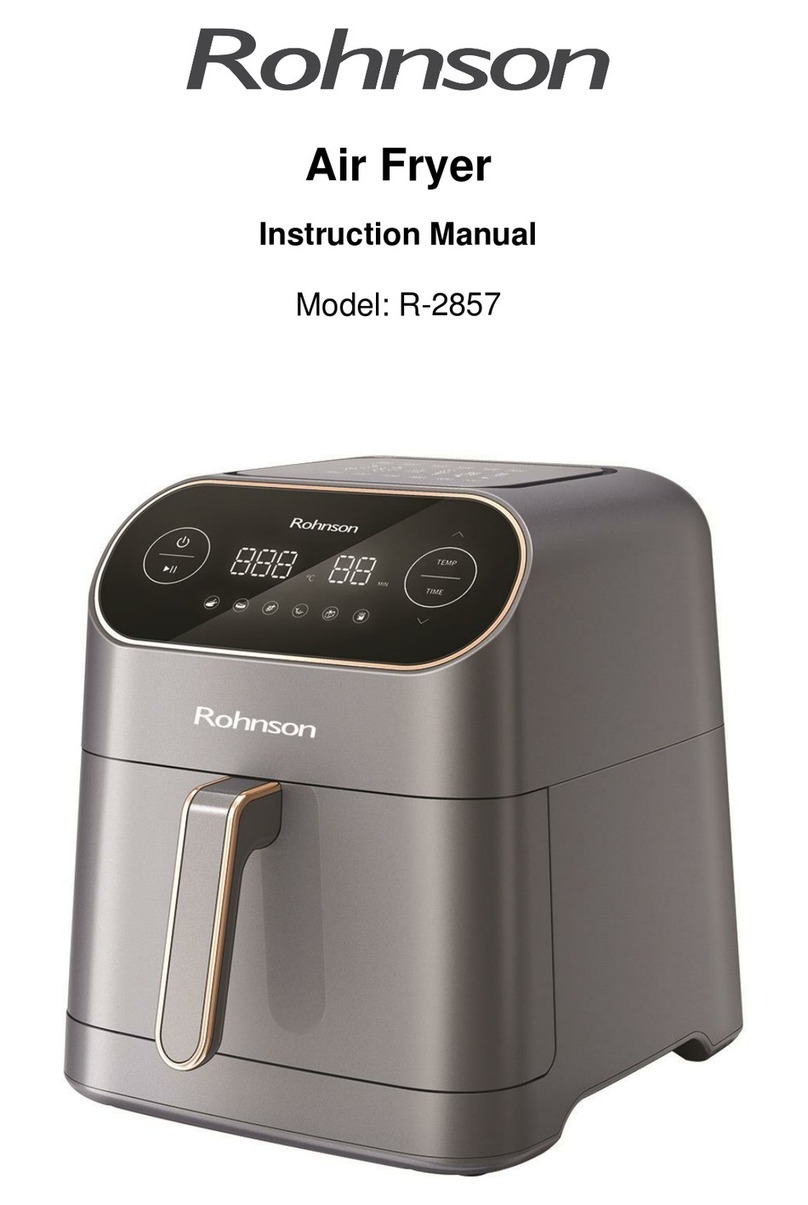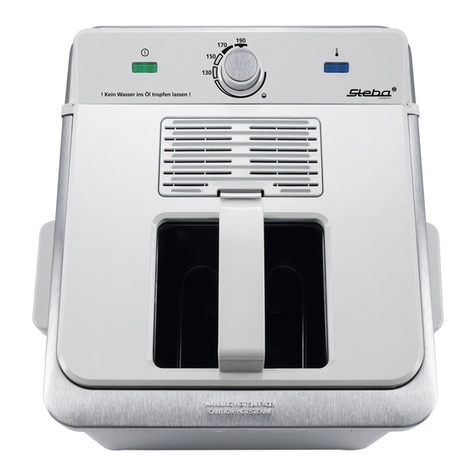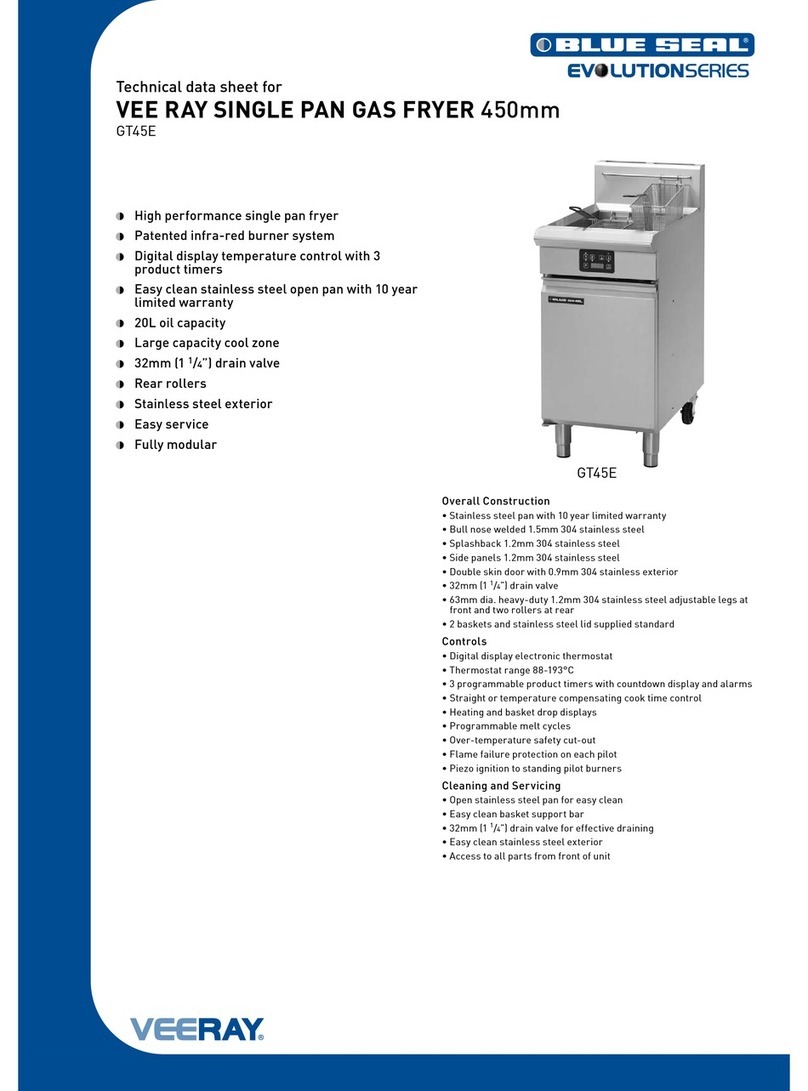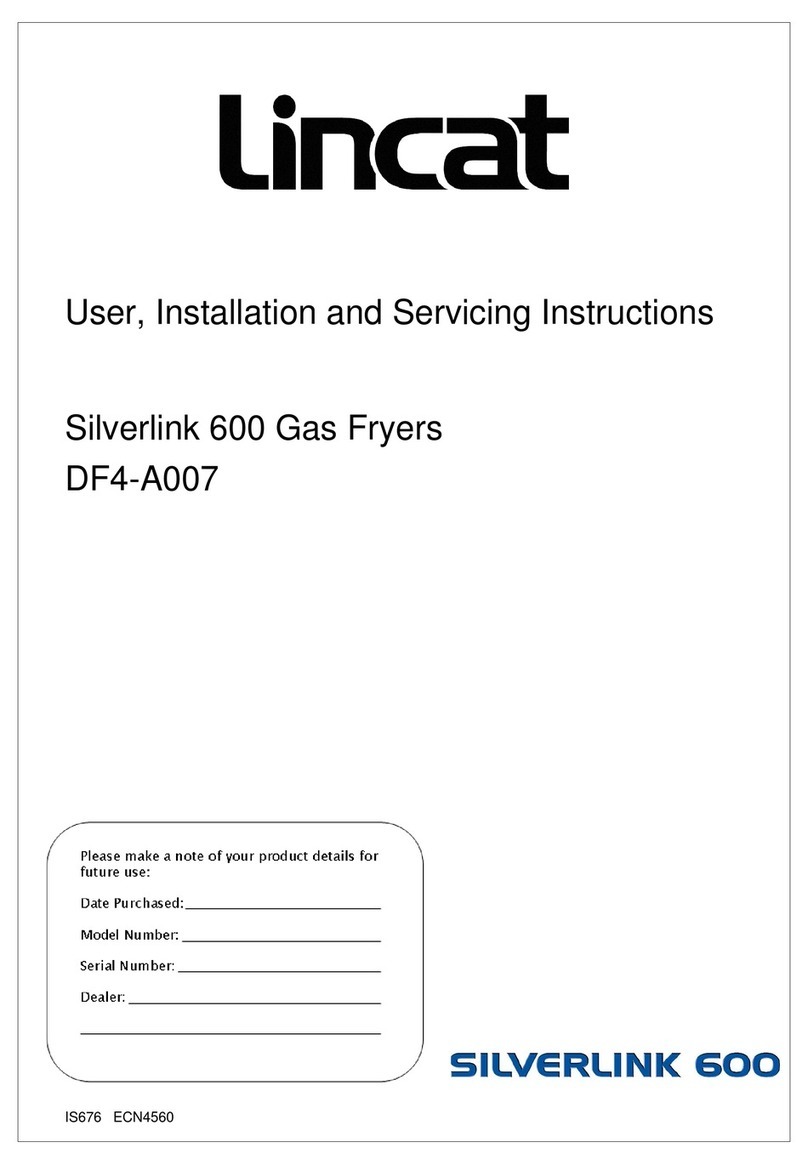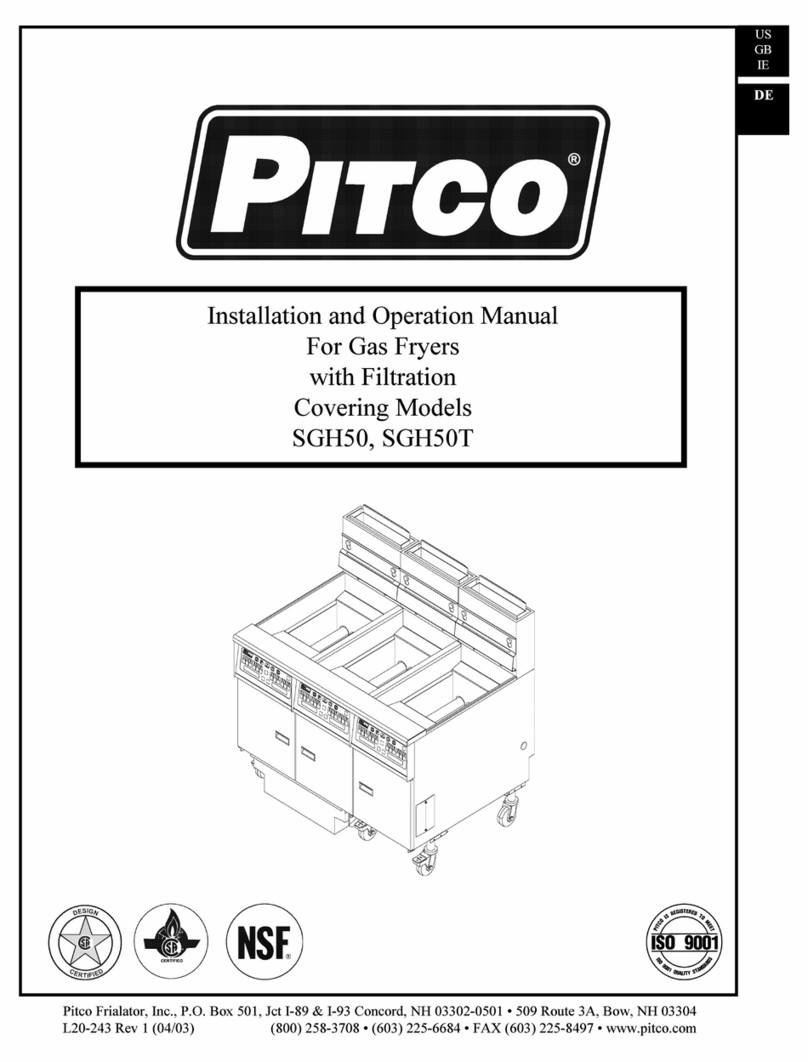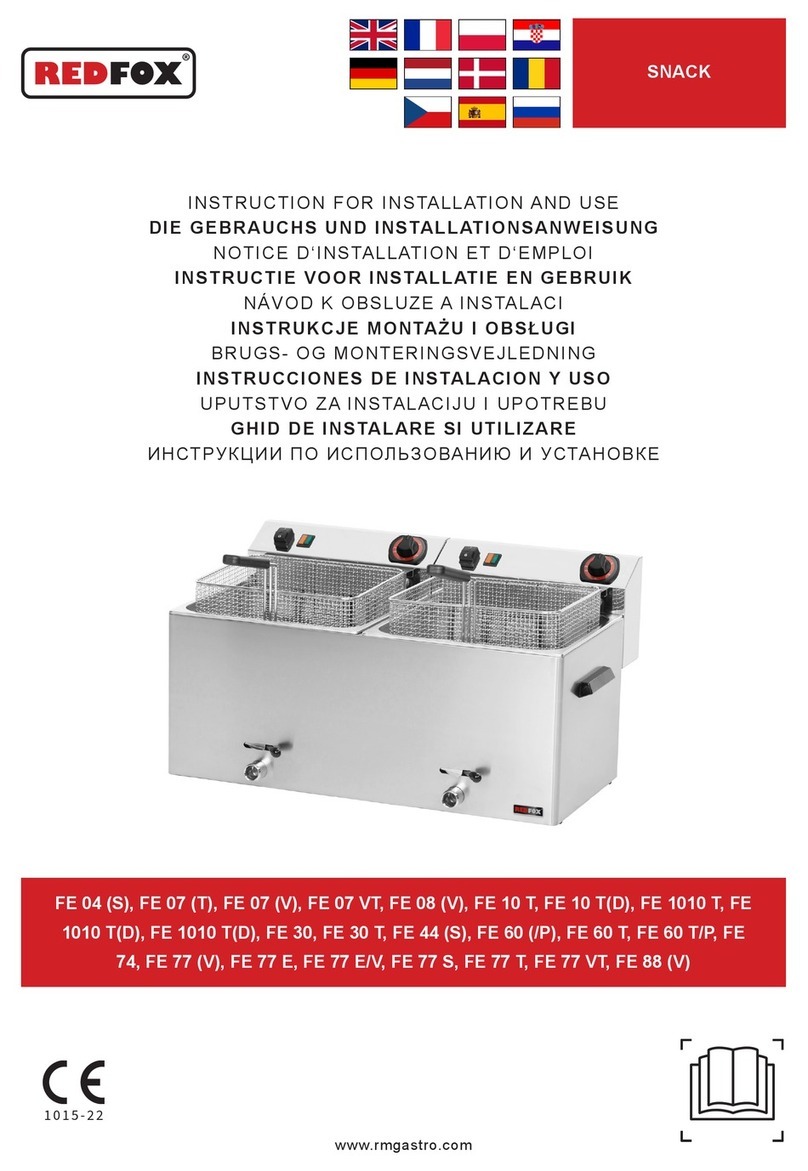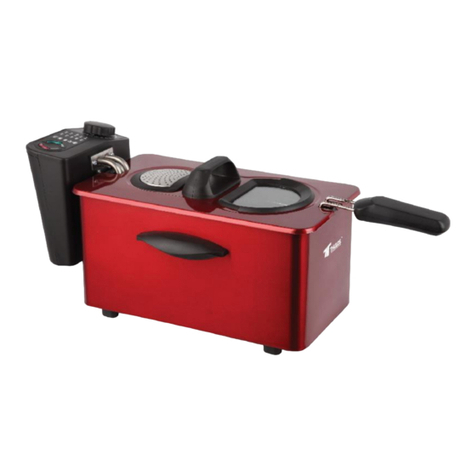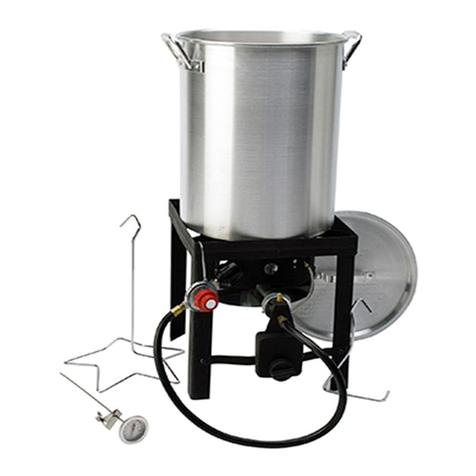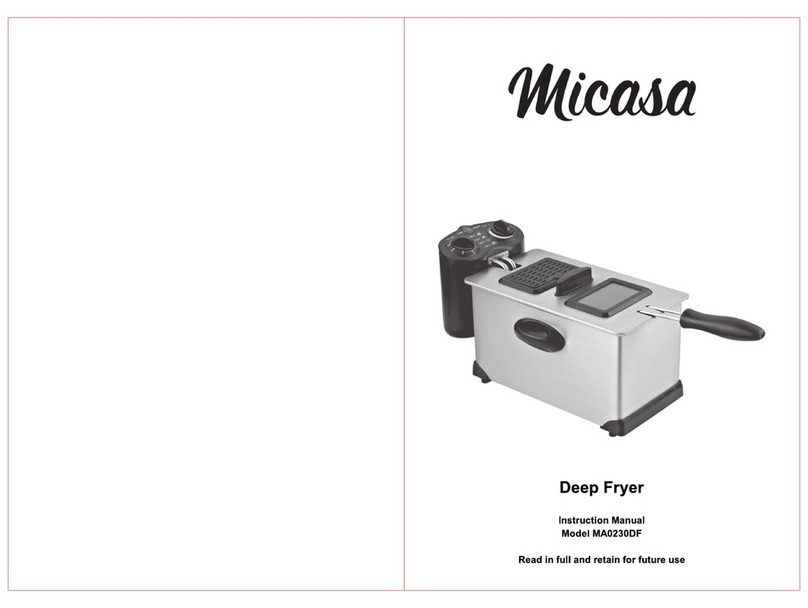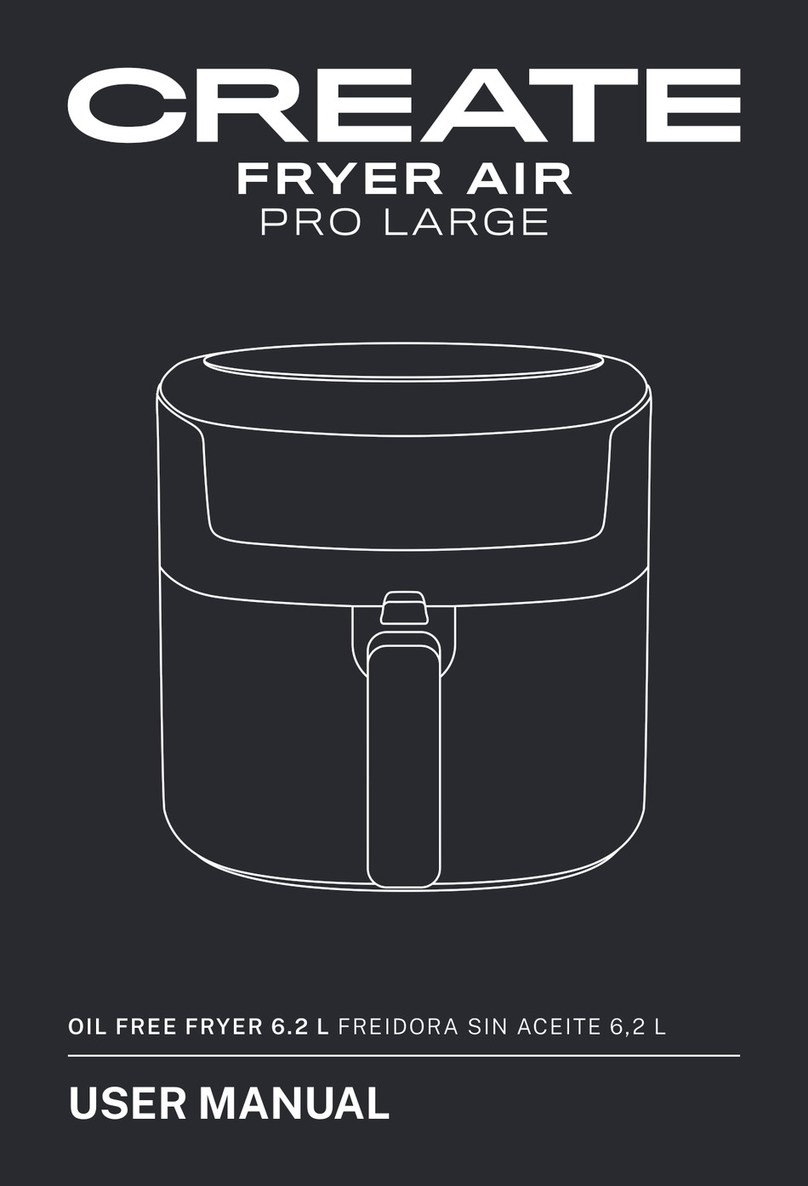Dean Dean D Guide

Dean, a member of the Commercial Food Equipment Service Association, recommends using
CFESA Certified Technicians.
24-Hour Service Hotline
1-800-551-8633
OCTOBER 2006
*8195922*
NON-CE &
Decathlon Series Gas Fryers
Service & Parts Manual
D, CFD, SCFD, FPD Models
PDF compression, OCR, web optimization using a watermarked evaluation copy of CVISION PDFCompressor

Please read all sections of this manual and retain for future reference.
This product has been certified as commercial cooking equipment and MUST be installed by
professional personnel as specified. Installation, maintenance and repairs should be performed
by your FRYMASTER FACTORY AUTHORIZED SERVICE CENTER.
DANGER
Do not store or use gasoline or other flammable vapors and liquids in the vicinity of this or any
other cooking appliance.
DANGER
Instructions explaining procedures to be followed MUST be posted in a prominent location in
the event the operator detects a gas leak. This information can be obtained from the local gas
company or gas supplier.
WARNING
Improper installation, adjustment, alteration, service or maintenance can cause property
damage, injury or death. Read the installation, operating and maintenance instructions
thoroughly before installing or servicing this equipment.
DANGER
Safe and satisfactory operation of your equipment depends on proper installation. Installation
MUST conform with local codes, or in absence of local codes, with the National Fuel Gas Code,
ANSI Z223.1; The Natural Gas Installation Code, CAN/CGA-B149.1; The Propane Installation
Code, CAN/CGA-B149.2; or The latest edition of the National Electric Code, N.F.P.A. 70.
NOTICE
If, during the warranty period, the customer uses a part for this Enodis equipment other than an
unmodified new or recycled part purchased directly from Frymaster and Dean, or any of its
authorized service centers, and/or the part being used is modified from its original
configuration, this warranty will be void. Further, Frymaster and Dean and its affiliates will not
be liable for any claims, damages or expenses incurred by the customer which arise directly or
indirectly, in whole or in part, due to the installation of any modified part and/or part received
from an unauthorized service center.
DANGER
The crumb tray in fryers equipped with a filter system must be emptied into a fireproof container
at the end of frying operations each day. Some food particles can spontaneously combust if left
soaking in certain shortening material. Additional information can be obtained in the filtration
manual included with the system.
PDF compression, OCR, web optimization using a watermarked evaluation copy of CVISION PDFCompressor

DANGER
The front ledge of the fryer is not a step. Do not stand on the fryer. Serious injury can result
from slips or contact with the hot oil.
WARNING
Drawings and photos used in this manual are intended to illustrate operational, cleaning and
technical procedures and may not conform to on-site management operational procedures.
WARNING
No structural material on the fryer should be altered or removed to accommodate placement of
the fryer under a hood. Questions? Call the Frymaster and Dean Service Hotline at 1-800-551-
8633.
This equipment is to be installed in compliance with the basic plumbing code of The Building
Officials and Code Administrators International, Inc. (BOCA) and the Food Service Sanitation
Manual of the Food and Drug Administration.
COMPUTERS
FCC
This device complies with Part 15 of the FCC rules. Operation is subject to the following two conditions:
1) This device may not cause harmful interference, and 2) This device must accept any interference
received, including interference that may cause undesired operation. While this device is a verified Class
A device, it has been shown to meet the Class B limits.
CANADA
This digital apparatus does not exceed the Class A or B limits for radio noise emissions as set out by the
ICES-003 standard of the Canadian Department of Communications.
Cet appareil numerique n’emet pas de bruits radioelectriques depassany les limites de classe A et B
prescrites dans la norme NMB-003 edictee par le Ministre des Communcations du Canada.
DANGER
THIS PRODUCT CONTAINS CHEMICALS KNOWN TO THE STATE OF CALIFORNIA TO CAUSE
CANCER AND/OR BIRTH DEFECTS OR OTHER REPRODUCTIVE HARM.
Operation, installation, and servicing of this product could expose you to airborne particles of
glasswool or ceramic fibers, crystalline silica, and/or carbon monoxide. Inhalation of airborne
particles of glasswool or ceramic fibers is known to the State of California to cause cancer.
Inhalation of carbon monoxide is known to the State of California to cause birth defects or other
reproductive harm.
WARNING
Do not bang fry baskets or other utensils on the fryer’s joiner strip. The strip is present to seal
the joint between the fry vessels. Banging fry baskets on the strip to dislodge shortening will
distort the strip, adversely affecting its fit. It is designed for a tight fit and should only be
removed for cleaning.
PDF compression, OCR, web optimization using a watermarked evaluation copy of CVISION PDFCompressor

Decathlon Series Gas Fryers
Service and Parts Manual
TABLE OF CONTENTS
1. SERVICE PROCEDURES……..……..……………………………………………...
1.1 Functional Description............................................................................................1-1
1.2 Accessing Fryers for Service...................................................................................1-8
1.3 Cleaning the Gas Valve Vent Tube (if applicable)..............................................1-10
1.4 Adjusting Burner Manifold Gas Pressure..........................................................1-10
1.5 Adjusting the Pilot Flame......................................................................................1-11
1.6 Calibrating the Thermatron Controller and Backup Thermostat....................1-11
1.7 Replacing Fryer Components...............................................................................1-13
1.8 Troubleshooting and Problem Isolation..............................................................1-32
1.9 Troubleshooting Guides........................................................................................1-41
1.10 Wiring Diagrams....................................................................................................1-43
2. PARTS LIST…….…………………………………..……………………………….
2.1 Decathlon Primary Components............................................................................2-1
2.2 Control Panel Options; D60 Series.......................................................................2-13
2.3 Optional Components and Controllers................................................................2-14
2.4 Transformers and Component Boxes; Multi-batteried Decathlon...................2-17
2.5 Oil Drain Manifold Components..........................................................................2-18
2.6 Oil Return Manifold Components........................................................................2-22
2.7 Oil Return and Oil Flush Components................................................................2-26
2.8 Under Fryer Filter (UFF) Components; D50 and D60 Series............................2-30
2.9 Single Under Fryer Filter (SUFF) Components..................................................2-35
2.10 Basket Lift Components; D50, D60, and D80......................................................2-39
2.11 Trough, Holster, and Cover Components; D60 and D80 Series........................2-41
PDF compression, OCR, web optimization using a watermarked evaluation copy of CVISION PDFCompressor

FINDING YOUR WAY AROUND THE DEAN DECATHLON
Top Cap
Flue Cap
Basket Hanger Frypot
Drain Tubes
Drain Valve Handle (Red)
Oil Return Handle (Yellow)
Drain Flush Handle (Blue)
Filter Unit
Electronic Operating
Thermostat
Drain Tubes
Burners
PDF compression, OCR, web optimization using a watermarked evaluation copy of CVISION PDFCompressor

DECATHLON SERIES GAS FRYERS
CHAPTER 1: SERVICE PROCEDURES
1-1
1.1 Functional Description
Decathlon Series gas fryers contain a welded steel frypot (stainless or cold-rolled) heated by gas
flames diffused evenly through tubes built into the frypot.
Flames originate from orifices in a burner manifold positioned beneath cast-iron burners. The
burners are positioned in the tube openings, at the front of the frypot. The diameter of the orifices
differs for natural (CE:G20/G25) and LP (CE:G31) gas as indicated in the accompanying table.
NON-CE
(
Altitudes of 2000 feet or less
)
EQUIPMENT
PRESSURE
MODEL INPUT
(BTU) GAS
TYPE
ORIFICE
MM
(INCH)
ORIFICE
PART NO. QTY MBAR INCH W.C.
D20G 50
NAT
LP 2.18(#44)
1.40(#54) 810-2050
810-2324 2
2 10
27.5 4
11
D50G 85
NAT
LP 2.08(#45)
1.32(#55) 14-0067-45
810-2441 4
4 10
27.5 4
11
D50G(HP) 120 NAT
LP 2.53(#39)
1.51(#53) 810-2048
810-2059 4
4 10
27.5 4
11
D50GDDHP 115 NAT
LP 2.44(#41)
1.51(#53) 14-0067-41
810-2059 4
4 10
27.5 4
11
D60G 112
NAT
LP 2.08(#45)
1.32(#55) 14-0067-45
810-2441 5
5 10
27.5 4
11
D60G(HP) 150 NAT
LP 2.53(#39)
1.51(#53) 810-2048
810-2059 5
5 10
27.5 4
11
D80G 122
NAT
LP 2.26(#43)
1.40(#54) 810-2049
810-2324 5
5 10
27.5 4
11
D80G(HP) 165 NAT
LP 2.58(#38)
1.61(#52) 810-2062
810-2063 5
5 10
27.5 4
11
CE ONLY
(
Altitudes of 2000 feet or less
)
EQUIPMENT
PRESSURE
MODEL INPUT
(kW) GAS
TYPE
ORIFICE
MM
(INCH)
ORIFICE
PART NO. QTY/
COLOR MBAR INCH W.C.
D20G 15,0
G20
G25
G31
2,40
2,40
1,51
810-2060
810-2060
810-2059
2/BLUE
2/BLUE
2/RED
10,0
15,0
27,0
4,0
6,0
10,8
D50G 30,0
G20
G25
G31
2,40
2,40
1,51
810-2060
810-2060
810-2059
4/BLUE
4/BLUE
4/RED
10,0
15,0
27,0
4,0
6,0
10,8
D60G 37,5
G20
G25
G31
2,40
2,40
1,51
810-2060
810-2060
810-2059
5/BLUE
5/BLUE
5/RED
10,0
15,0
27,0
4,0
6,0
10,8
D80G 37,5
G20
G25
G31
2,40
2,40
1,51
810-2060
810-2060
810-2059
5/BLUE
5/BLUE
5/RED
10,0
15,0
27,0
4,0
6,0
10,8
PDF compression, OCR, web optimization using a watermarked evaluation copy of CVISION PDFCompressor

DECATHLON SERIES GAS FRYERS
CHAPTER 1: SERVICE PROCEDURES
1-2
1.1 Functional Description (cont.)
An electromechanical gas valve regulates gas flow to the manifold. Decathlon Series gas fryers are
equipped with either a 120V valve system or a 24V valve system. Unit configurations include either
a pilot ignition system (standing pilot) or an electronic ignition system.
Pilot System Configuration
The pilot system is comprised of the pilot orifice, pilot hood, and a thermopile. The pilot serves two
purposes: light the burner and heat the thermocouple (some systems incorporate a thermopile). In
operation, the thermocouple is in contact with the pilot flame and generates millivolts. The millivolt
output energizes the gas valve pilot coil, which in turn opens the pilot valve. If the pilot flame is
extinguished, the gas valve pilot coil loses voltage and the pilot valve closes. The main valve of the
gas valve will not open if the pilot valve is not open. The pilot flame must be manually lit when the
fryer is first placed into operation. A separate 120V circuit, activated by the fryer ON/OFF switch,
provides voltage through the Thermatron to the gas valve main coil, which opens the main valve.
Electronic Ignition Configuration
In units configured for electronic ignition, an ignition module connected to an ignitor assembly
replaces the pilot system. The ignition module performs three important functions: provide an
ignition spark, supply voltage to the gas valve, and proof the pilot flame.
PDF compression, OCR, web optimization using a watermarked evaluation copy of CVISION PDFCompressor

DECATHLON SERIES GAS FRYERS
CHAPTER 1: SERVICE PROCEDURES
1-3
Electronic Ignition Configuration (cont.)
The module contains a 60-second time delay circuit and a coil that activates the gas valve. The
ignitor assembly consists of a spark plug, a pilot, and a flame sensor element.
At start-up the ON/OFF switch is placed in the ON position, supplying 12 VDC to the heat control
circuitry in the controller or computer and to one side of the heat relay coil on the interface board. If
resistance in the temperature probe indicates the temperature in the frypot is below 180°F (82°C),
the current flows through a melt cycle circuit where a timer switch alternately closes for 3 seconds
and opens for 24 seconds. If the temperature is 180°F (82°C) or above, the current flows through a
heat circuit, bypassing the timer switch. In either case, current is supplied to the other leg of the heat
relay coil which then closes an electronic switch in the 24 VAC circuit to provide current to the
ignition module. NOTE: The listed melt cycle times and exit temperature pertain to the Compu-Fry
computer only.
Circuitry in the ignition module sends 24 VAC current to the gas valve via a normally closed high-
limit switch and a drain safety switch. Simultaneously, the module causes the ignitor to spark for up
to 60 seconds to light the pilot flame. A flame sensor verifies that the pilot is lit by measuring the
flow of microamps through the flame. If the pilot does not light (or is extinguished), current to the
ignition module is interrupted, preventing the main valve from opening, and the ignition module
"locks out" until the power switch is turned OFF, then back ON.
A temperature probe monitors the temperature in the frypot. When the programmed setpoint
temperature is reached, resistance in the probe causes the heat cycle circuitry in the controller to
interrupt current flow through the heat relay. This in turn interrupts the 24 VAC current to the
ignition module, resulting in closure of the gas valve.
NOTE: In September 2006, these modules were replaced with black Honeywell modules (Kit, 826-
2117). Operationally they are similar. The new modules have a 4.5 second delay before sparking
and lockout at 90 seconds. Unlike previous modules, microamp readings on the new black modules
will move up and down as the module pulses on and off and this is an indication that the module is
functioning.
When installing the new modules into an older unit with a Fast GO board, a resistor (provided in
module kit) is needed to adjust melt cycle to accommodate the 4.5 second delay.
Control Options
Decathlon Series gas fryers may be equipped with operating thermostat controls (optional backup-
only; available with electronic thermostat or computer), Thermatron, or Compu-Fry computers.
In fryers equipped with Thermatron, the fryer is turned on and off by means of a rocker switch and
the temperature is set by adjusting a potentiometer. An interface board is located in the component
box (shield) behind the control panel (computer-equipped) or in a component box inside the cabinet
(Thermatron-equipped).
PDF compression, OCR, web optimization using a watermarked evaluation copy of CVISION PDFCompressor

DECATHLON SERIES GAS FRYERS
CHAPTER 1: SERVICE PROCEDURES
1-4
Interface Boards
The interface board provides a link between the controller/computer and the fryer’s individual
components without requiring excessive wiring, and allows the controller to execute commands
from one central point. Two types of interface boards may be used in Decathlon Series gas fryers;
the type used depends on the fryer configuration.
In units configured for Thermatron, P/N 826-2086 (115/230V) is used; in units configured for
Compu-Fry computers, P/N 106-6710 is used.
IFB 826-2086 (115/230V): These boards are used in Decathlon fryers equipped with Thermatron
control systems.
Thermatron systems incorporate a temperature probe, a potentiometer, and a temperature control
circuit board. This system is more accurate and reliable than a standard thermostat. The temperature
probe measures oil temperature via resistance (ohms); as oil temperature rises, resistance decreases.
The potentiometer sets the oil temperature via resistance (ohms). The temperature control circuit
board compares the resistance from the probe and potentiometer and cycles the burner on and off as
necessary.
THERMATRON P/N 826-2086
PDF compression, OCR, web optimization using a watermarked evaluation copy of CVISION PDFCompressor

DECATHLON SERIES GAS FRYERS
CHAPTER 1: SERVICE PROCEDURES
1-5
Interface Boards (cont.)
IFB 106-6669 & 106-6710: These interface boards are used in Decathlon fryers with Frymaster
computer control systems.
INTERFACE BOARD P/N 106-6669
INTERFACE BOARD P/N 106-6710
PDF compression, OCR, web optimization using a watermarked evaluation copy of CVISION PDFCompressor

DECATHLON SERIES GAS FRYERS
CHAPTER 1: SERVICE PROCEDURES
1-6
Interface Boards (cont.)
FREQUENTLY USED TEST POINTS FOR INTERFACE BOARD P/N 806-4549 (previous style)
Test Meter Setting Pins Test Results
12VAC Power to Controller 50VAC Scale 1 and 3 on J3 12-18
24VAC Power to Right Module 50VAC Scale 8 on J3 and GROUND 22-28
24VAC Power to Left Module 50VAC Scale 8 on J1 and GROUND 22-28
12VDC Power to Right BL Relay 50VDC Scale 7 on J2 and 9 or 12 on J3 12-18
12VDC Power to Left BL Relay 50VDC Scale 9 on J2 and 9 or 12 on J1 12-18
24VAC Power to Right High-Limit 50VAC Scale 7 on J3 and GROUND 22-28
24VAC Power to Left High-Limit 50VAC Scale 7 on J1 and GROUND 22-28
120VAC Power* 250VAC Scale 11 on J3 and GROUND 110-125
120VAC Power To 120VAC Gas Valve* 250VAC Scale 10 on J3 and GROUND 110-125
Probe Resistance (Right)** R x 1000 Ohms 2 on J3 and 4 on J3 ***
Probe Resistance (Left)** R x 1000 Ohms 2 on J1 and 4 on J1 ***
* Where Applicable
** Disconnect 15-pin harness from controller before testing probe circuit.
*** See Probe Resistance Charts in this chapter.
P/N 806-4549 INTERFACE BOARD (previous style)
LED DIAGNOSTIC LIGHTS
12V Indicates 12 VAC from transformer
24V Indicates 24 VAC from transformer
GV Indicates 24 VAC to gas valve
PWR Indicates 24 VAC to PWR via K1 (L) or K2 (R or F)
AIR Not Applicable to Decathlon Series Gas Fryers
The board contains two heat relays (K2 and K3), and two basket lift relays (K1 and K4). NOTE: On
factory-original units not equipped with basket lifts and on service interface boards, the board will
have no basket lift relays installed.
(See next page for current flow through the interface board.)
PDF compression, OCR, web optimization using a watermarked evaluation copy of CVISION PDFCompressor

DECATHLON SERIES GAS FRYERS
CHAPTER 1: SERVICE PROCEDURES
1-7
Interface Boards (cont.)
CURRENT FLOW THROUGH INTERFACE
BOARD 806-4549 (previous style)
2
5
8
11
J3
J2
1
2
4
5
6
7
8
9
10
11
12
13
14
15
2
5
11
J1
LEFT TWIN VAT SINGLE OR RIGHT TWIN-VAT
INTERFACE BOARD
12 VAC TO CPTR J3 PIN 3
GROUND GROUND
3
12 VAC RETURN J3 PIN 1
COMPUTER RT HT RELAY (K3)
COMPUTER LT HT RELAY (K2)
COMPUTER K4
NOT USED NOT USED
COMPUTER K1
RT ALARM OUT** ALR (RIGHT)
COMPUTER SOUND DEVICE
LT ALARM OUT* AD (LEFT)
COMPUTER J3 PIN 4
COMPUTER
COMPUTER J1 PIN 4
J1 PIN 2 & J3 PIN 2
J2 PIN 14 TEMP PROBE
24 VAC IN
AC COMMON
COMPUTER 12 VDC TO RELAYS
NOT USEDNOT USED
AC COMMON AC COMMON AC COMMON
PWR via K2
NOT USED NOT USED
J2 PIN 14TEMP PROBE
V2D
PWR
AD
AS
V2S
GND
V1D
PWR
ALR
V1S
GND
MOD 25V GROUND GROUND
MOD V2D
MOD 25V TERM
DRAIN SWITCH (OPT) J2 PIN 12
NOT USED NOT USED
NOT USED NOT USED
GROUND MOD 25V GROUND
J3 PIN 7 MOD V1D*
MOD 25V TERM
J3 PIN 8 via K2
DRAIN SWITCH (OPT)J2 PIN 10
MOD V1S**
*
* Twin Vat configurations
** Single Vat configurations
J3 PIN 7
J1 PIN 7
J1 PIN 8 via K1
12
K4 BASKET LIFT (UP)
10
AC Hot to 120VAC GV
7MAIN GAS VALVE 24VACV1S OR V1D
via HLS
9
K4 BASKET LIFT (DN)
4
J2 PIN 13 TEMP PROBE
6
NOT USED NOT USED
1
J2 PIN 3 12 VAC XFMR PIN 12
3
J2 PIN 1 12 VAC XFMR PIN 11
3
NOT USED NOT USED
1NOT USEDNOT USED
6
NOT USED NOT USED
4
TEMP PROBE J2 PIN 15
9
BASKET LIFT (DN) K1
7
MAIN GAS VALVE V2D
via HLS
8
24 VAC IN PWR via K1
12
BASKET LIFT (UP) K1
10
NOT USED NOT USED MAIN GAS VALVE 120VAC
via HLS
PDF compression, OCR, web optimization using a watermarked evaluation copy of CVISION PDFCompressor

DECATHLON SERIES GAS FRYERS
CHAPTER 1: SERVICE PROCEDURES
1-8
Thermostats
Different types of thermostats are used in Decathlon Series gas fryers, depending on fryer
configuration.
Fryers equipped with an optional backup operating-thermostat and/or Thermatron use a dial to
adjust temperature. In this configuration, the probe resistance varies directly with the temperature.
As the temperature rises, resistance decreases at a rate of approximately 2 ohms for every 1°F
(approximately 3.7 ohms for every 1°C).
Fryers equipped with computer controls have a temperature probe. In this configuration, the probe
resistance varies directly with the temperature. As the temperature rises, resistance increases at a
rate of approximately 2 ohms for every 1°F (approximately 3.7 ohms for every 1°C). Circuitry in the
computer monitors the probe resistance and controls burner firing when the resistance exceeds or
falls below programmed temperatures (setpoints). The temperatures are programmed by means of a
keypad on the face of the computer.
All Decathlon Series gas fryers are equipped with a high-limit thermostat. In the event that the fryer
fails to control the oil temperature, the high-limit thermostat prevents the fryer from overheating to
flash point. The high-limit thermostat acts as a normally closed power switch that opens when
exposed to temperatures above 410°F/210°C (CE) to 450°F/232°C (non-CE). CE and non-CE high-
limits are not interchangeable.
1.2 Accessing Fryers for Servicing
DANGER
Moving a fryer filled with cooking oil may cause spilling or splattering of the hot
liquid. Follow the draining instructions included with the fryer before attempting to
relocate a fryer for servicing.
1. Shut off the gas supply to the unit. Unplug the power cords. Remove any attached restraining
devices.
2. Disconnect the unit from the gas supply.
3. Relocate the fryer for service accessibility.
4. After servicing is complete, reconnect the unit to the gas supply, reattach restraining devices, and
plug in the electrical cords.
DANGER
No structural material on the fryer should be altered or removed to accommodate
placement of the fryer under a hood. Questions? Call the Frymaster Dean Service
Hotline at 1-800-551-8633.
PDF compression, OCR, web optimization using a watermarked evaluation copy of CVISION PDFCompressor

DECATHLON SERIES GAS FRYERS
CHAPTER 1: SERVICE PROCEDURES
1-9
Restraints
Once the fryer has been positioned at the frying station, use a carpenter’s level placed across the top
of the frypot to verify that the unit is level, both side-to-side and front-to-back.
To level fryers equipped with legs, the bottom of the legs can be screwed out up to one inch for leveling.
Legs should also be adjusted so that the fryer(s) are at the proper height in the frying station.
For fryers equipped with casters, there are no built-in leveling devices. The floor where the fryers
are installed must be level.
When the fryer is leveled in its final position, install the restraints provided with the unit to limit its
movement so that it does not depend on or transmit stress to the electrical conduit or connection.
Install the restraints in accordance with the provided instructions (see illustration below). If the
restraints are disconnected for service or other reasons, they must be reconnected before the fryer is
used.
DANGER
Adequate means must be provided to limit the movement of this appliance without
depending on or transmitting stress to electrical conduits or gas supply line. A
restraint kit is provided with the fryer. If the restraint kit is missing contact your
local Frymaster Factory Authorized Service Center (FASC) for part number 826-0900.
NOTE:If you need to relocate a fryer installed with legs, remove all weight from each leg
before moving. If a leg becomes damaged, contact your service agent for immediate repair or
replacement.
DANGER
Hot oil can cause severe burns. Avoid contact. Under all circumstances, oil must be
removed from the fryer before attempting to move it to avoid oil spills, falls, and
severe burns. This fryer may tip and cause personal injury if not secured in a
stationary position.
PDF compression, OCR, web optimization using a watermarked evaluation copy of CVISION PDFCompressor

DECATHLON SERIES GAS FRYERS
CHAPTER 1: SERVICE PROCEDURES
1-10
1.3 Cleaning the Gas Valve Vent Tube (if applicable)
1. Set the fryer power switch and the gas valve to the OFF position.
2. Carefully unscrew the vent tube from the gas valve. NOTE: The vent tube may be straightened
for ease in removal.
3. Pass a piece of ordinary binding wire (.052 inch diameter) through the tube to remove any
obstruction. Remove the wire and blow through the tube to ensure it is clear.
4. Reinstall tube and bend so that the opening is pointing downward.
1.4 Adjusting Burner Manifold Gas Pressure
WARNING
This task should be performed by qualified service personnel only.
1. Ensure that the gas valve knob is in the OFF position.
2. Remove the pressure tap plug from the gas valve (see arrows in photos below for location).
3. Insert the manometer fitting into the pressure tap hole.
4. Place the gas valve in the ON position then place the fryer power switch in the ON position.
When the burner lights and continues to burn, check the gas pressure reading against the table on
page 1-1.
5. To adjust burner gas pressure, remove the cap from the gas valve regulator and adjust to correct
pressure.
6. Place the fryer power switch and the gas valve in the OFF position. Remove the manometer
fitting from the pressure tap hole and reinstall the pressure tap plug.
Non-CE Electronic
Ignition Valve
Pilot Ignition Valve
(Line Voltage) CE Pilot Ignition Valve
PDF compression, OCR, web optimization using a watermarked evaluation copy of CVISION PDFCompressor

DECATHLON SERIES GAS FRYERS
CHAPTER 1: SERVICE PROCEDURES
1-11
1.5 Adjusting the Pilot Flame
1.5.1 Main Pilot
1. Remove the cap from the pilot adjustment screw hole on the gas valve.
2. Using a small, flat-tipped screwdriver, turn the pilot adjusting screw counterclockwise to
increase length of flame or clockwise to decrease length of flame. Adjust to obtain a flame from
1 inch to 1½ inches long.
3. Reinstall the pilot adjustment screw cap.
1.5.2 Trailing Pilot
In older Decathlon units, the trailing pilot may need adjusting. Adjust the trailing pilot valve located
on the burner manifold until a flame from 1 inch to 1½ inches long is obtained. Current production
units do not have an adjustment.
1.6 Calibrating the Thermatron
(and Optional Backup Operating Thermostat)
1.6.1 Thermatron
1. Fill the frypot to the lower OIL-LEVEL line with cooking oil. If solid shortening is used, it must
be melted before starting the calibration procedure.
2. Ensure the fryer ON/OFF switch is in the OFF position and light the pilot.
3. Place the fryer ON/OFF switch in the ON position. Set the electronic thermostat dial to 325°F
(162°C).
4. Allow the oil to equalize at setpoint temperature. This is evident when the burners have cycled
on and off several times.
5. Insert a thermometer or pyrometer into the frypot within 3 inches of the probe bulb. Ensure the
tip of the thermometer/pyrometer does not touch the frypot burner-tube.
6. If the temperature on the thermometer is higher or lower than 325°F (162°C), the knob is out of
calibration.
7. Calibrate the knob by first loosening the setscrew and slowly turn the knob to match the
temperature reading of the thermometer. Tighten the setscrew, ensuring the knob does not move
on the shaft during tightening.
8. Allow burners to cycle on and off several times, then recheck oil temperature as described in
Step 5. If the thermostat dial temperature matches the thermometer temperature, the thermostat
is calibrated. If not, repeat Step 7.
PDF compression, OCR, web optimization using a watermarked evaluation copy of CVISION PDFCompressor

DECATHLON SERIES GAS FRYERS
CHAPTER 1: SERVICE PROCEDURES
1-12
1.6.2 Backup Operating Thermostat (Optional)
1. Fill the frypot to the lower OIL-LEVEL line with oil. If solid shortening is used, it must be
melted before starting the calibration procedure.
2. Light the pilot.
3. Set the temperature control knob to 350°F/177°C.
4. Let the burners cycle on and off automatically three times in order for the cooking oil
temperature to become uniform. If necessary, stir to get all shortening in the bottom of the
frypot melted.
5. Insert a thermometer or pyrometer probe into the oil, with the end near the fryer temperature-
sensing probe.
NOTE: The temperature-sensing probe is mounted on the frypot tube.
6. When the burner starts for the fourth time, the thermometer/pyrometer reading should be within
the range 335-360°F (168-182°C). If it is not, calibrate as follows:
a. Remove the thermostat knob by pulling straight out on the knob with a firm, steady pull.
The temperature adjusting screw is located in the middle of the thermostat shaft.
b. Insert a small-bladed flat-tipped screwdriver into the adjusting screw. Turn the adjusting
screw in ¼-turn increments to adjust the temperature. Turning the screw clockwise
decreases the temperature; turning it counter-clockwise increases the temperature. DO NOT
allow the thermostat shaft to turn while turning the adjusting screw.
c. Recheck the thermometer/pyrometer reading the next time the burner comes on.
d. Repeat steps 6.b. through 6.c. until the thermometer/pyrometer reading remains within the
range 335-360°F (168-182°C) through several cycles. If calibration cannot be obtained for
any reason, call a Factory Authorized Service Center for service.
e. Reinstall the thermostat knob.
7. Remove the thermometer or pyrometer.
PDF compression, OCR, web optimization using a watermarked evaluation copy of CVISION PDFCompressor

DECATHLON SERIES GAS FRYERS
CHAPTER 1: SERVICE PROCEDURES
1-13
1.7 Replacing Fryer Components
1.7.1 Replacing the Computer
1. Disconnect the fryer from the electrical
supply.
2. Unscrew the two computer panel screws.
The computer panel is hinged at the bottom
and will swing open from the top.
3. Unplug the fryer wiring harness and ground
wire from the back of the computer.
4. Remove the computer by lifting it from the
hinge slots in the fryer control panel frame.
5. Reverse the procedure to install a new
computer.
Computer panel in “down” position.
Disconnect the 15-pin connector and ground
wire (arrows) from the computer.
Control
p
anel frame with com
p
uter removed.
PDF compression, OCR, web optimization using a watermarked evaluation copy of CVISION PDFCompressor

DECATHLON SERIES GAS FRYERS
CHAPTER 1: SERVICE PROCEDURES
1-14
1.7.2 Replacing the Backup Thermostat (if applicable)
1. Disconnect the fryer from the electrical supply.
2. Drain cooking oil from frypot.
3. Remove thermostat knob.
4. Disconnect the wiring plug(s) from the component shield/control box.
5. Disconnect leads from terminal block.
6. Remove screws securing the thermostat bracket to fryer.
7. Follow Steps 5-7 in Section 1.7.4, Replacing the High-limit Thermostat, to remove thermostat
from frypot.
8. Remove the defective thermostat from the thermostat bracket and replace with a known good
thermostat. Use care not to damage the probe bulb and lead on the new thermostat.
9. Reverse the above steps to install the replacement.
CAUTION
The backup operating thermostat must be calibrated after installation is complete.
Refer to Section 1.6.2 for calibration instructions.
PDF compression, OCR, web optimization using a watermarked evaluation copy of CVISION PDFCompressor

DECATHLON SERIES GAS FRYERS
CHAPTER 1: SERVICE PROCEDURES
1-15
1.7.3 Replacing the Temperature Probe; Computer-equipped Fryers
1. Disconnect the fryer from the electrical supply.
2. Drain cooking oil from the frypot. Allow the
frypot to cool completely before proceeding.
3. Remove the fryer door for easier access to
the temperature probe. D models: Lift door up,
disengage rod from lower door bracket, and
remove door. CFD/SCFD/FPD models:
Remove the top bracket and hinge, then
remove door.
4. Disconnect the probe harness connector
(arrow). Use a pin pusher to remove plug from
probe wires (probe side only). Retain the plug
for re-assembly on new probe.
5. a. 1.5” drains: Remove drain extension from
elbow on drain valve. Set aside for
reassembly. Drain extensions will vary in
shape and size according to fryer model.
b. 3” drains:
-Remove the nuts holding the drain valve
straps onto the drain tube studs.
-Disconnect the Teflon tube at the back of
the T-shaped center tube piece.
-Disconnect any other components
attached to the tubes.
-Carefully remove the tubes by pulling
down at an angle, straight out of the drain
valves.
-Set aside for reassembly.
NOTE: Dean fryers may be equipped with either 1.5”
or 3” drains. Follow the instructions appropriate for
the drain type used.
On units with 3” drains, remove the nuts, Teflon tube
(not pictured), clamp, boot, and drain tubes. (Step 5.B)
Disconnect the two-pin probe harness connector
(arrow). On units with 1.5” drains, remove the drain
extension from the elbow on the drain valve.
PDF compression, OCR, web optimization using a watermarked evaluation copy of CVISION PDFCompressor
Other manuals for Dean D
1
This manual suits for next models
3
Table of contents
Other Dean Fryer manuals
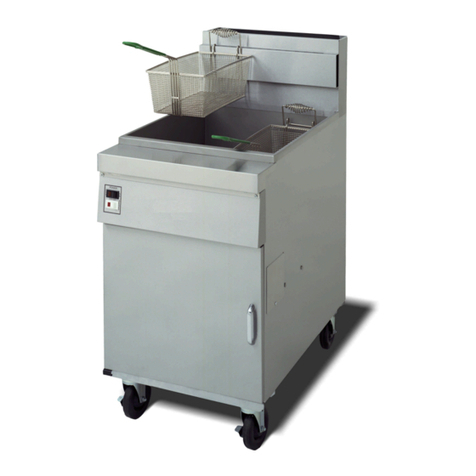
Dean
Dean D20 Series User manual
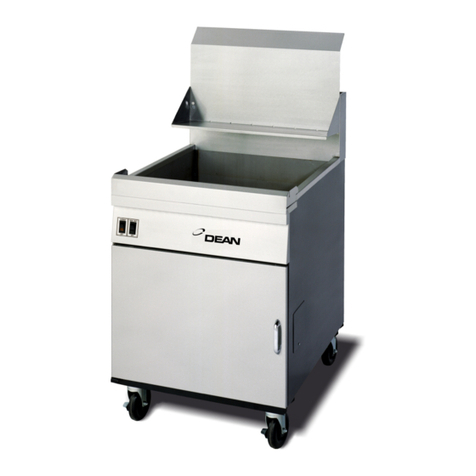
Dean
Dean 1824G User manual

Dean
Dean SM20 GM User manual
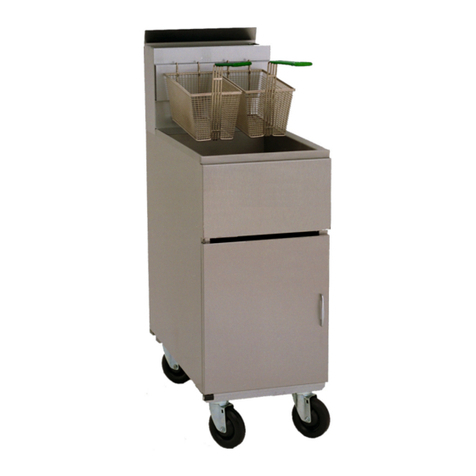
Dean
Dean Super Marathon Series User manual
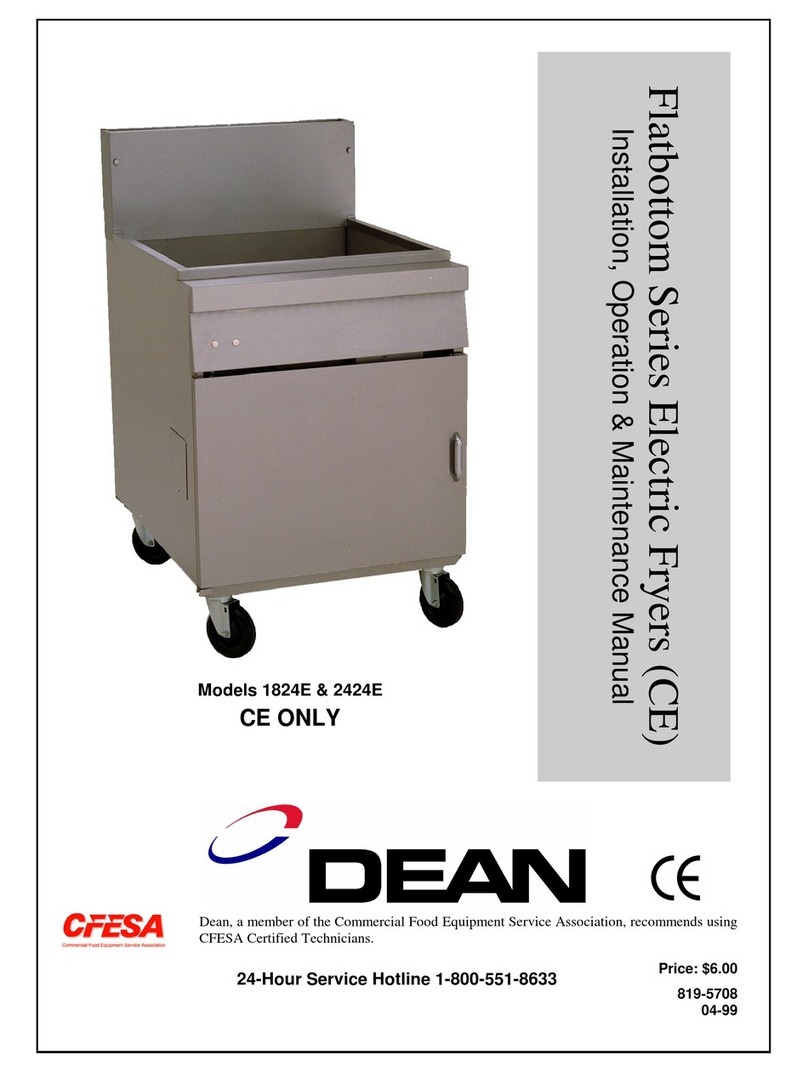
Dean
Dean Dean 1824E Instruction manual
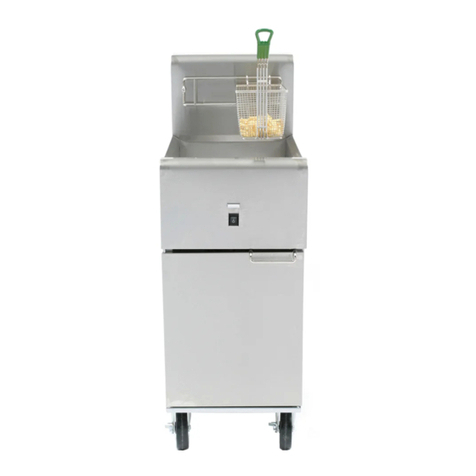
Dean
Dean SR114E User manual

Dean
Dean Cool Zone Electric Fryer Guide
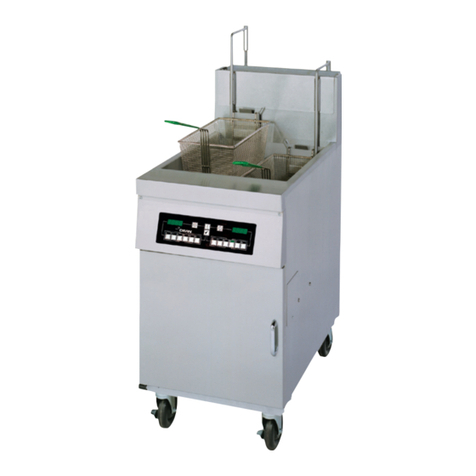
Dean
Dean D160G* User manual

Dean
Dean D20 Series Guide

Dean
Dean 1824G User manual
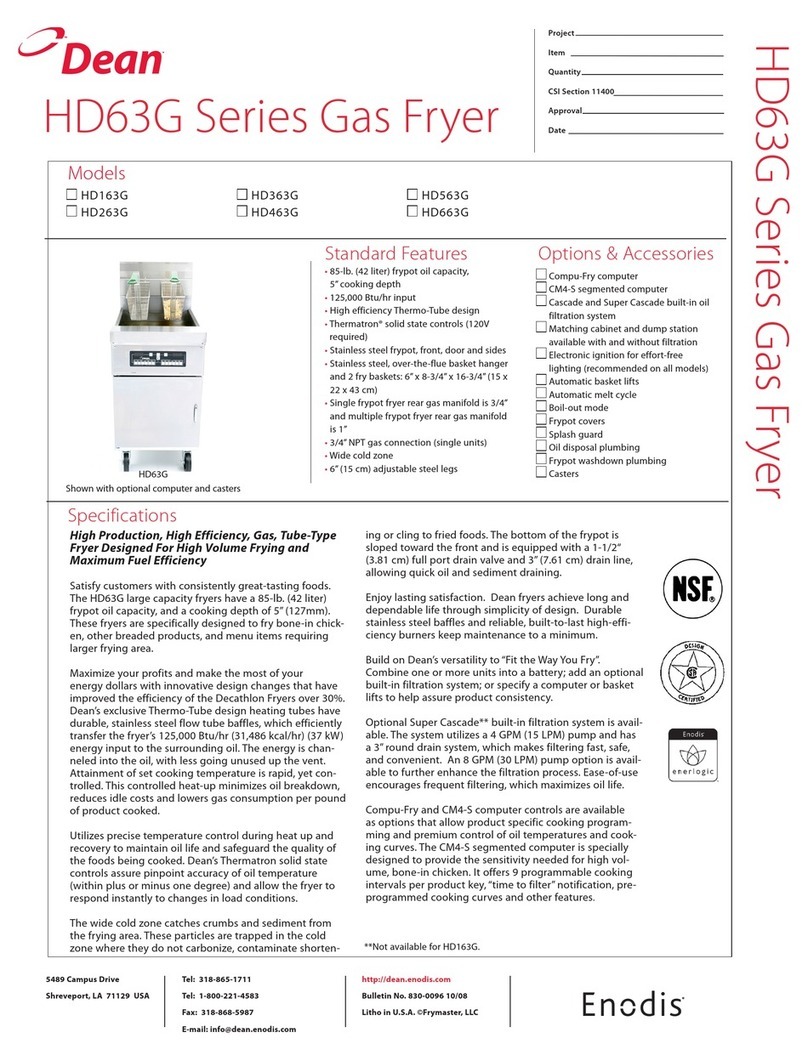
Dean
Dean HD63G Series User manual
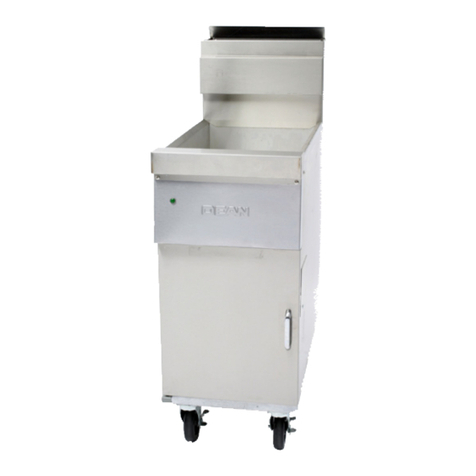
Dean
Dean HD50G Aust User manual

Dean
Dean BK1814 Guide
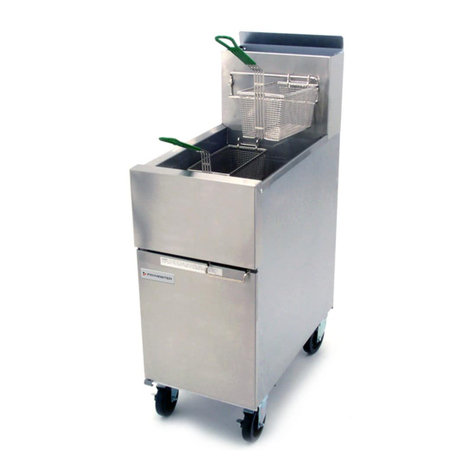
Dean
Dean SR42 Series User manual
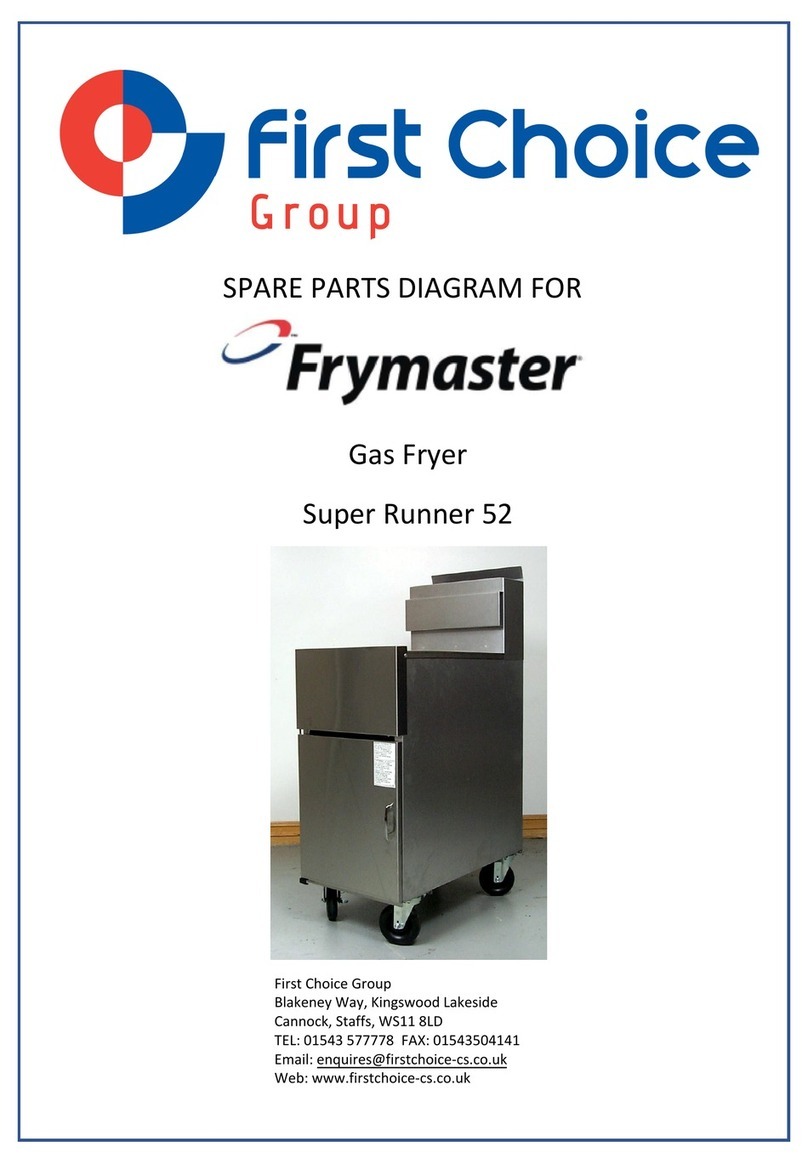
Dean
Dean Frymaster Super Runner 52 Series User manual
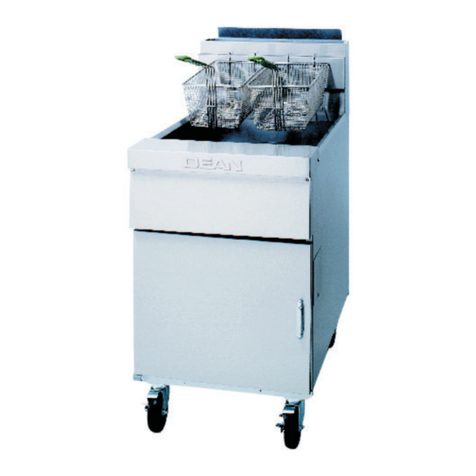
Dean
Dean SM80G User manual
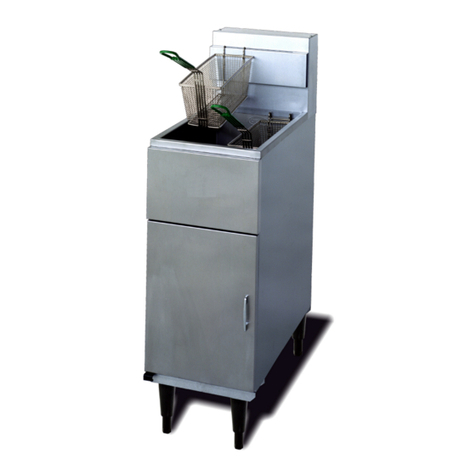
Dean
Dean Electric Fryer User manual
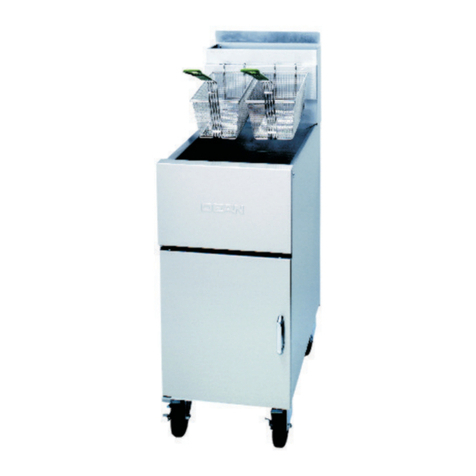
Dean
Dean SM40G User manual

Dean
Dean TC25 User manual
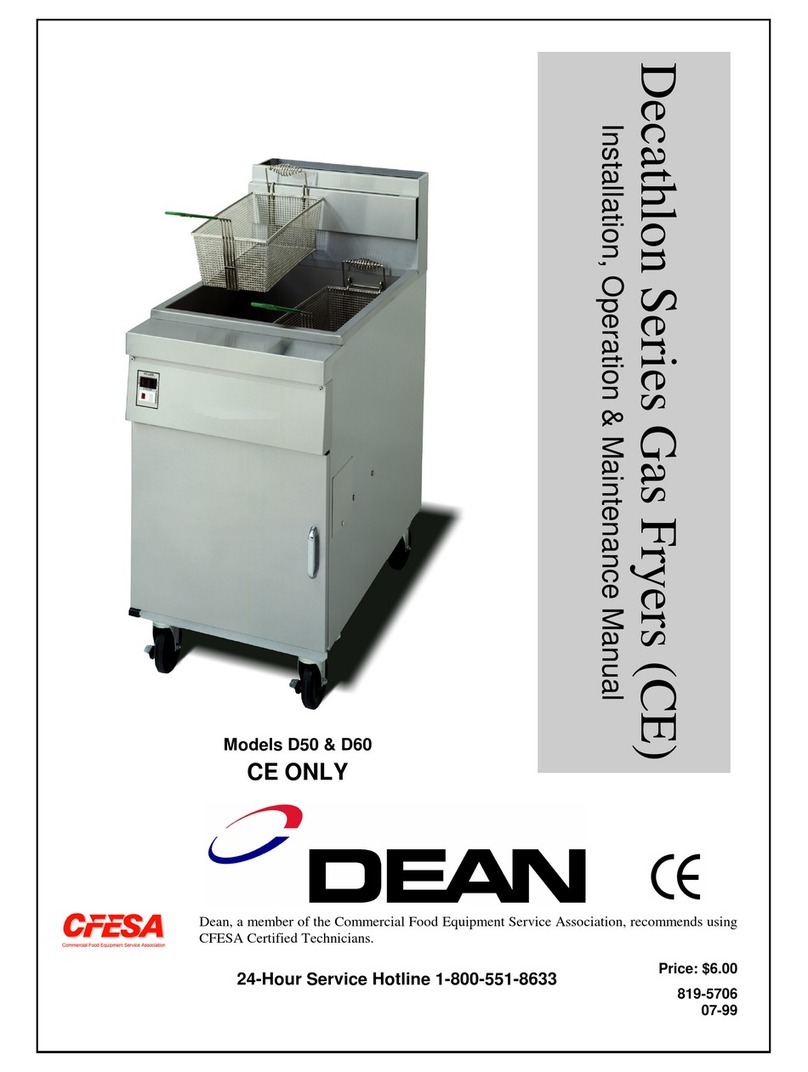
Dean
Dean D50 Series Instruction manual
